Improve Your Learning
Question 1.
What is a force? What changes can be produced by a force?
Answer:
Force: A push or a pull of an object is called a force.
Changes produced by a force:
- A force can change the state of motion of an object.
- A force can change the shape of an object.
Question 2.
State an example for a situation mentioned below in which a force:
a) Changes the speed of an object.
b) Changes the shape of an object.
c) Changes the direction of an object.
Answer:
a) Force changes the speed of an object:
A ball at rest begins to move when a force is applied on it that shows force changes the speed of an object.
b) Force changes the shape of an object:
Take a plastic or metal scale placed between two bricks and put some weight at the centre of the scale. We observe that force changes its shape.
c) Force changes the direction of an object:
Kick a moving football with some angle then we can observe the change in the direction of football.
Question 3.
How can you differentiate between a contact force and a force at a distance?
(OR)
Distinguish between a contact force and a force at a distance.
Answer:
| Contact force |
A force at a distance |
| 1. Force which results when there is a direct physical contact between two interacting objects is known as contact force. |
1. The force which occurs without any physical contact between two objects is known as a force at a distance or field force. |
| 2. The two objects have direct contact. |
2. No contact. |
| 3. For example, the tyres of a bicycle has direct contact with the surface of the road. |
3. For example, the attraction of two magnets. |
Question 4.
Give two examples each for a contact force and a force at a distance.
Answer:
Contact force:
e.g.: 1) Muscular force 2) Frictional force Force at a distance:
e.g.: 1) Magnetic force 2) Electrostatic force
Question 5.
Detect the errors in the following statement and rewrite it making necessary corrections.
“Because the car is at rest, no forces are acting on it.”
Answer:
The object is said to be at rest when no forces are acting on it or net force acting on it is zero. So the statement should be corrected like this “Because the car is at rest, no forces are acting on it or net force on the car is zero.”
Question 6.
Why do tools meant for cutting always have sharp edges?
Answer:
The tools meant for cutting have sharp edges because of smaller contact area they exerts more pressure on objects and cutting of objects are easy.
Question 7.
Objects change their state of motion due to the net force acting on them. Do you agree with this statement ? Discuss with examples.
Answer:
Yes, we can agree with this statement. Net force can increase or decrease the speed of an object. Force can also change the direction of an object.
Hence we conclude that net force can change the state of motion of an object.
Some examples:
- If we kick the ball it will move from state of rest.
- If we stop the running ball it will come to state of rest.
- If we through a ball on the ground it will come to rest after sometime due to gravitational force acting on it.
- If we pull the chair, it will move due to muscular force acting on it.
Question 8.
When you push a heavy object, it doesn’t move. Explain the reason in terms of net force.
Answer:
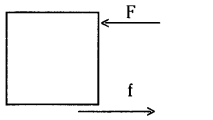
When we apply force on a heavy object it has to overcome frictional force in order to move. If the force applied is less than the frictional force then the net force (f - F) is insufficient to move the object.
Question 9.
Find net forces from the following diagrams:

Answer:
a) Net force is 6N along horizontal direction towards right.
b) Net force is zero.
c) Net force is 14N along horizontal direction towards right.
d) Net force is 1 N upwards in vertical direction.
Question 10.
Imagine that friction has disappeared from the earth. What will happen? Explain.
Answer:
If friction has disappeared from the earth then
- we cannot walk or run.
- we will not have any cars or bicycles because all of them move due to friction.
- no building could be constructed.
- carpenters will not able to smoothen surfaces.
- we could not fix nail on the wall.
- it will not possible to write with pen or pencil.
- we will not able to hold any appliances such as hammer, soap, etc.
Question 11.
Karthik is observing the live telecast of a one day cricket match. He noticed motion of a roller on the pitch during lunch break. He thought about various forces acting on the roller and the net force when it is in motion. Many questions arose in his mind regarding the direction of the net force. Can you guess what would be those questions?
Answer:
- Why there is no motion for roller in vertical direction?
- What are the forces acting in the vertical direction?
- What are the forces acting in the horizontal direction?
- Why there is motion in the horizontal direction for roller?
Question 12.
a) Take two identical straws and suspend one of them freely. Rub the other straw with a piece of paper. Bring the rubbed end of the straw near the suspended one. What do you observe from this activity? Can you tell which type of force is it?
b) Comb your dry hair. Bring the comb near small pieces of paper. What do you observe? Explain.
Answer:
a) The rubbed end of the straw attracts the suspend straw when it is brought near to it. The reason is that when the straw is rubbed with a paper, it acquires an electrostatic charge on its surface and the suspended straw near it acquires opposite charge.
b) When we comb dry hair and bring small pieces of paper they are attracted by comb the reason is when we comb dry hair, it acquires electrostatic charge and paper pieces brought near to it acquire opposite charge there by they are attracted by comb.
Question 13.
Collect pictures from various sources like internet, magazines, newspapers, etc. to illustrate contact forces, forces and prepare a scrap book.
Answer:

Question 14.
A stick is placed on steps as shown in the figure. Draw normal forces on the stick.
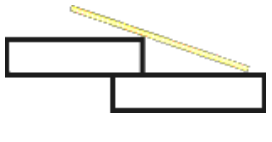
Answer:
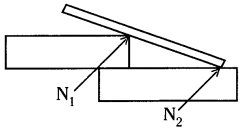
Question 15.
A monkey hangs stationary at the end of the vertical vine. What forces act on the monkey
Answer:
a) The weight of the monkey downward direction.
b) The normal force by branch upward direction.
c) The frictional force exerted by branch along the horizontal direction.
Question 16.
If you push on a heavy box which is at rest, you must exert some force to start its motion. However, once the box is sliding, you can apply a lesser force to maintain that motion. Why?
Answer:
When the box is sliding, the contact points on its surface do not get enough time to lock in to the contact points on the floor. So friction is less when compared with box at rest so we required to apply lesser force to maintain motion.
Question 17.
How do you increase the pressure by keeping
(a) area unchanged and (b) force unchanged?
Answer:
Pressure P = hdg. So pressure can be depend on height of air column, density of air and acceleration due to gravity.
So pressure can be increased by increasing length of air column at a particular place and for a particular gas.
Question 18.
Design and conduct experiments to test few ways how friction may be reduced.
Answer:
Friction is due to the roughness of surfaces. It can be reduced by the following methods.
- By polishing the rough surface.
- By applying lubricants like oil and grease to the surfaces.
- By spreading powder on the rough surface like carromboard.
- By using soap and detergent solutions, etc.
Experiment: The rusted pulley makes a rattling noise. Apply some oil in between the wheel and axle. The sound is reduced and now it works smoothly.
Question 19.
Observe the figure and find in which direction the force of friction acts. Also indicate the normal forces and their directions.
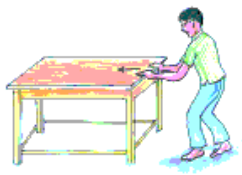
Answer:
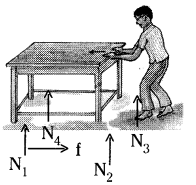
f: force of friction
N1, N2, N3, N4 are normal forces.
Question 20.
A man is standing still on a level floor. What forces act on him? Draw a free body diagram (FBD) to show all forces acting on him.
Answer:
The forces acting on the man:
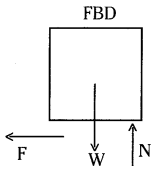
Along vertical direction:
- Weight of the man or gravitational force acting vertically downwards.
- Normal force or reaction applied by the floor vertically up.
Along horizontal direction:
Frictional force applied by the floor on the man.
Question 21.
How do you appreciate the role of friction in facilitating our various activities?
Answer:
Every motion that occurs on earth depends upon friction. For example, we are unable to walk if there is no friction and we cannot write with a pen and we cannot construct a building and there should be no vehicles without friction.
So without friction there is no motion on earth. So friction is required for better living of human beings.